The Intel Core i9-9900KS Review: The 5 GHz Consumer Special
by Dr. Ian Cutress on October 31, 2019 10:45 AM ESTCPU Performance: Web and Legacy Tests
While more the focus of low-end and small form factor systems, web-based benchmarks are notoriously difficult to standardize. Modern web browsers are frequently updated, with no recourse to disable those updates, and as such there is difficulty in keeping a common platform. The fast paced nature of browser development means that version numbers (and performance) can change from week to week. Despite this, web tests are often a good measure of user experience: a lot of what most office work is today revolves around web applications, particularly email and office apps, but also interfaces and development environments. Our web tests include some of the industry standard tests, as well as a few popular but older tests.
We have also included our legacy benchmarks in this section, representing a stack of older code for popular benchmarks.
All of our benchmark results can also be found in our benchmark engine, Bench.
WebXPRT 3: Modern Real-World Web Tasks, including AI
The company behind the XPRT test suites, Principled Technologies, has recently released the latest web-test, and rather than attach a year to the name have just called it ‘3’. This latest test (as we started the suite) has built upon and developed the ethos of previous tests: user interaction, office compute, graph generation, list sorting, HTML5, image manipulation, and even goes as far as some AI testing.
For our benchmark, we run the standard test which goes through the benchmark list seven times and provides a final result. We run this standard test four times, and take an average.
Users can access the WebXPRT test at http://principledtechnologies.com/benchmarkxprt/webxprt/
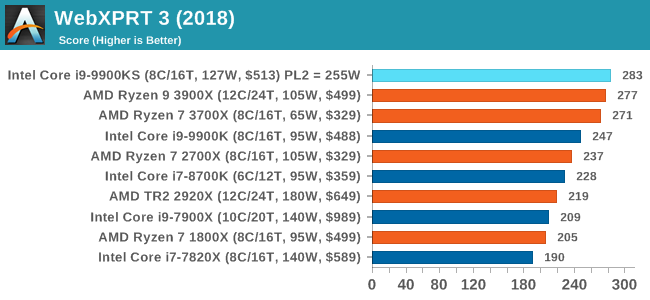
WebXPRT 2015: HTML5 and Javascript Web UX Testing
The older version of WebXPRT is the 2015 edition, which focuses on a slightly different set of web technologies and frameworks that are in use today. This is still a relevant test, especially for users interacting with not-the-latest web applications in the market, of which there are a lot. Web framework development is often very quick but with high turnover, meaning that frameworks are quickly developed, built-upon, used, and then developers move on to the next, and adjusting an application to a new framework is a difficult arduous task, especially with rapid development cycles. This leaves a lot of applications as ‘fixed-in-time’, and relevant to user experience for many years.
Similar to WebXPRT3, the main benchmark is a sectional run repeated seven times, with a final score. We repeat the whole thing four times, and average those final scores.
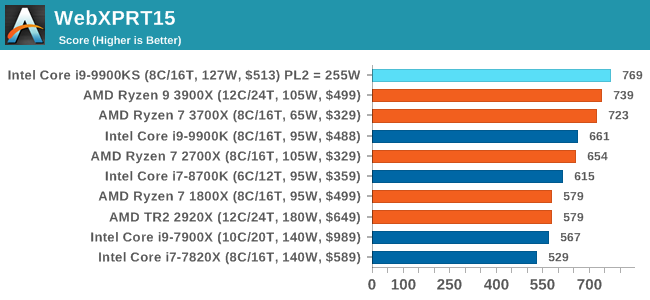
Speedometer 2: JavaScript Frameworks
Our newest web test is Speedometer 2, which is a accrued test over a series of javascript frameworks to do three simple things: built a list, enable each item in the list, and remove the list. All the frameworks implement the same visual cues, but obviously apply them from different coding angles.
Our test goes through the list of frameworks, and produces a final score indicative of ‘rpm’, one of the benchmarks internal metrics. We report this final score.
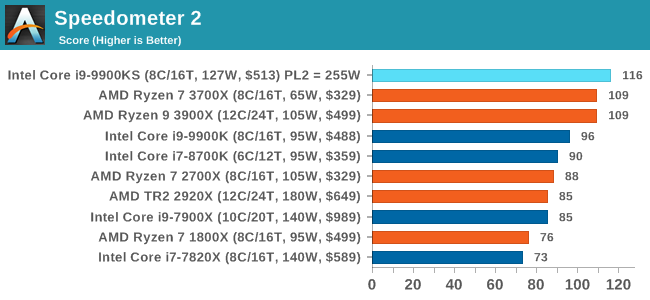
Google Octane 2.0: Core Web Compute
A popular web test for several years, but now no longer being updated, is Octane, developed by Google. Version 2.0 of the test performs the best part of two-dozen compute related tasks, such as regular expressions, cryptography, ray tracing, emulation, and Navier-Stokes physics calculations.
The test gives each sub-test a score and produces a geometric mean of the set as a final result. We run the full benchmark four times, and average the final results.
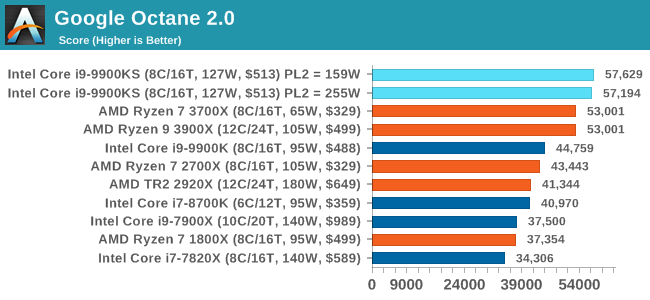
Mozilla Kraken 1.1: Core Web Compute
Even older than Octane is Kraken, this time developed by Mozilla. This is an older test that does similar computational mechanics, such as audio processing or image filtering. Kraken seems to produce a highly variable result depending on the browser version, as it is a test that is keenly optimized for.
The main benchmark runs through each of the sub-tests ten times and produces an average time to completion for each loop, given in milliseconds. We run the full benchmark four times and take an average of the time taken.
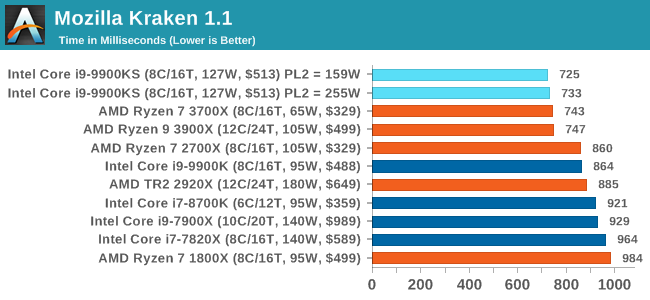
3DPM v1: Naïve Code Variant of 3DPM v2.1
The first legacy test in the suite is the first version of our 3DPM benchmark. This is the ultimate naïve version of the code, as if it was written by scientist with no knowledge of how computer hardware, compilers, or optimization works (which in fact, it was at the start). This represents a large body of scientific simulation out in the wild, where getting the answer is more important than it being fast (getting a result in 4 days is acceptable if it’s correct, rather than sending someone away for a year to learn to code and getting the result in 5 minutes).
In this version, the only real optimization was in the compiler flags (-O2, -fp:fast), compiling it in release mode, and enabling OpenMP in the main compute loops. The loops were not configured for function size, and one of the key slowdowns is false sharing in the cache. It also has long dependency chains based on the random number generation, which leads to relatively poor performance on specific compute microarchitectures.
3DPM v1 can be downloaded with our 3DPM v2 code here: 3DPMv2.1.rar (13.0 MB)
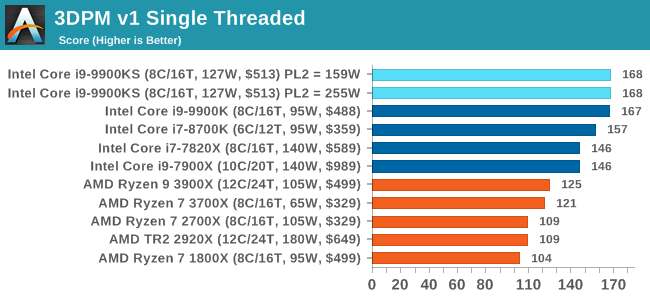
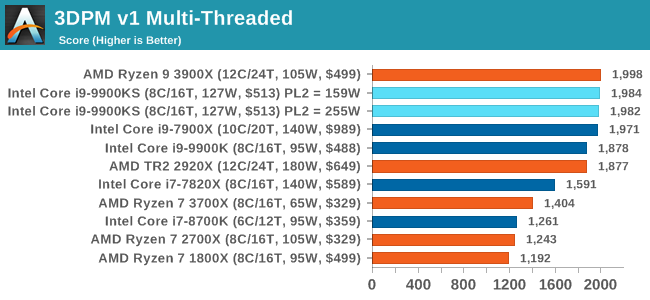
x264 HD 3.0: Older Transcode Test
This transcoding test is super old, and was used by Anand back in the day of Pentium 4 and Athlon II processors. Here a standardized 720p video is transcoded with a two-pass conversion, with the benchmark showing the frames-per-second of each pass. This benchmark is single-threaded, and between some micro-architectures we seem to actually hit an instructions-per-clock wall.
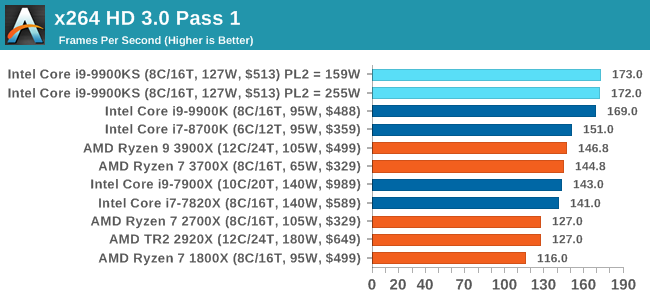











235 Comments
View All Comments
mattkiss - Friday, November 1, 2019 - link
The Processor Specification field in the CPU-Z screen shot has "(ES)" after the cpu name. Did you test and engineering sample or an actual retail sample?GreenReaper - Sunday, November 3, 2019 - link
It was only launched a couple of days ago, so they'd have to have had a sample, you couldn't run the tests and write the article having bought it at retail.BAF2782 - Friday, November 1, 2019 - link
Nice to see a 10+year old Thermalright True Copper: 2kg for a CPU that has a mini-nuclear thermal reactor powering itself. LoL. I can't really say much. I'm using a 11year old ZALMAN CNPS 9900MAX (300watt) AIR cooler on a 5.3GHz Golden 8700K with 1.380v in a z370 Aorus Gaming 7. I thought about getting a new cooler with the $400 open-box 9900K that i just found. But, after seeing the 9900KS running on the 10year old Thermalright True Copper: 2 kg. I don't have a doubt the ZALMAN 9900MAX (300watt) cooler will have any problems running a 5GHz (PO) 9900K.crotach - Saturday, November 2, 2019 - link
So, this is a direct competitor to 2700X, but costs twice as much?I wonder if we'll see intel as a budget offering in a couple of years, cutting the price of their 14nm tech to half of what AMD charges just to get some sales.
My my, how the tables have turned :)
Dragonstongue - Saturday, November 2, 2019 - link
if they can say 4ghs base, but 5ghz all core turbo, why not just have as 5ghz directly ??I confused, seems another marketing ploy of some sort (no real surprise there)
that being said, likely good for AMD as well as sets a new target for them TSMC et al.
Orkiton - Saturday, November 2, 2019 - link
It's like a Caterpillar engine that will need hydrogen fuel to beat most benchmarks. That means expensive Mobo, GPU, PSU, Mem, Cooler, Case.It's Intel stretching to the limits for PR purposes, yet much bellow AMD, in terms of value for money.
liquid_c - Sunday, November 3, 2019 - link
It's unbelievable, i swear. Even Anandtech's comment section has turned into a pcgamer shit show. Instead of just trying to take the article as it is - a piece of info, most of the people here either start a revolution against Intel or just plain dismiss it as "fake information" in regards to TDP. But i see nobody here admitting that Intel's 14nm is ON PAR with AMD's 7nm (i've heard they have the same density but don't quote me on that). Or that said products is not geared towards you or your acquaintances. I swear to God, it's like Intel has raped some family member or something. Just buy whatever you think is fit for you and leave others to enjoy proper journalism (which is so f*cking rare nowadays).liquid_c - Sunday, November 3, 2019 - link
*are not geared.Sigh, i miss an edit button :(
Korguz - Sunday, November 3, 2019 - link
cause it is fake info, 127 watts ?? nope, 200+ more then likely. and some i think, are tired of the lies, BS, and over charging intel has had us pay over the years. face it, if amd didnt bring out zen, the chances are we would still be stuck at quad core for the mainstream, and anything above that, would be HEDT. FYI, it may be on par, but intel should also be on 10nm by now... maybe even the next node size, and yet, intel kept saying, 10nm is on track. there are better, less expensive options then this cpu, this is just intel being intel, last ditch effort to try to save face.The Garden Variety - Sunday, November 3, 2019 - link
Thank you, liquid_c. This needs to be repeated over and over again. You have this stellar quality content, painstakingly researched and presented, and it's clear many of the readers (or at least the ones that comment) are neither understanding it, reading it in context, or even trying to think about it. The smartphone reviews are identical. It's all just "how do I read what I want so I can wage my emotional holy war because I have literally nothing else going for me."Here, I'll go one step further: there's zero reason for a site like Anandtech to have comments following articles at all. You could delete 9 out of 10 attached to this article and zero of value would be lost. Given how terribad the comment system is (no editing, tiny and unscalable input window, spam posts that go undetected for days, etc.) and the effort/investment it would likely take Anandtech's limited team to improve it, just getting the hell rid of it would be a far more sensible solution. Let the content be the star. Send people to the forums in a special board requiring a 500 post barrier in the broader community to contribute to article discussions.